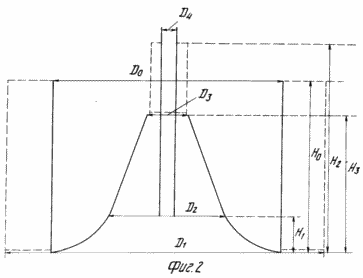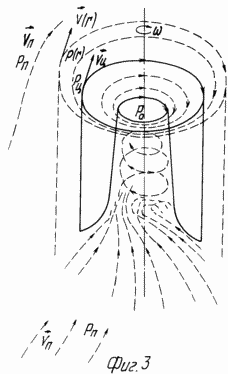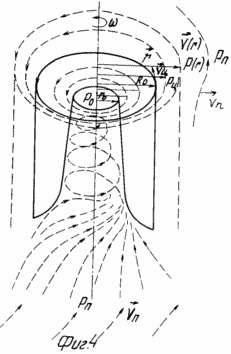| section Home
Production, Amateur Radio amateur Model aircraft, rocket- Useful, entertaining |
Stealth master
Electronics Physics Technologies invention |
space Mystery
Earth Mysteries Secrets of the Ocean Stealth section Map |
|
| Use of material is permitted for reference (for websites - hyperlinks) | |||
Navigation: => |
Home / Products Patents / In the section of the catalog / back / |
|
INVENTION
Russian Federation Patent RU2084692
![]()
CONVERSION METHOD energy flow in mechanical or electrical energy and surface water systems, sells it
Name of the inventor: Egorkin Yuri Y.
The name of the patentee: Egorkin Yuri Y.
Address for correspondence:
Starting date of the patent: 1993.05.28
Usage: hydropower and can be used to convert the kinetic energy of the flow of rivers, canals, chutes. The inventive channel flow energy into mechanical or electrical energy is carried out by changing the forward flow direction into a rotational movement of liquid and hydro energy converter, and the change of motion is carried out the formation of two vortices in the opposite direction of rotation, with a depth of the flow does not exceed three times the linear dimensions of hydro, provide matching speeds vortices and flow with the external sides of the vortices and flow at depth greater than three times the linear dimensions of hydro, provide the opposite direction of the vortices and flow rates from the external sides of the vortex. The riverbed Hydroplanting containing frame with two vertically arranged hollow bodies of revolution made in the form of hollow cylinders and located in the last PTO shafts arranged one above the other, two bladed turbines, with shafts mounted rotatably in opposite directions, each cylinder is provided with an inner wall formed as a tube of variable cross section, attached to form a channel tapering upwardly, shafts are tubular and fastened to the inner axis associated with the frame, the blades of the upper and lower turbines arranged symmetrically rotational axis and fixed to the outer lateral surfaces of the shaft and the cylinder, respectively, , being attached to the latter at an acute angle with the cylinder wall, the tube and the shaft are rigidly interconnected to form a single rotor system, and to provide a counter-rotating turbine blades of the rotors are oriented in different directions.
DESCRIPTION OF THE INVENTION
The invention relates to a hydroelectric and can be used to convert the kinetic energy of the flow of rivers, channels, chutes.
There is a method of fluid flow energy conversion into mechanical energy, and a device for its implementation (application USSR N 1634814, F 03 B 17/00, publ. 1991.), Containing the power take-off shaft, endless working body spanned by the rotary pulleys forth above and downstream of and relating to a PTO floating body made in form of extended in one direction of the floats attached to the working member.
The disadvantage of this method is the complexity and bulkiness of the structure, carrying out its complexity in operation and unnecessarily big-time free surface of the water basin.
Known riverbed hydraulic unit (aut.'s Certificate. USSR N 1700376, F 03 B 13/10, 7/00, publ. 1991.), In which the hydraulic turbine impeller shaft and blades symmetric profile installed in the tray with a gap with respect to its bottom and sides walls. Generator is kinematically connected to the shaft. Before the water turbine on the bottom wall of the ramp is installed, the height of the ramp and the gap between the side walls of the tray are determined from the proposed relationships.
The disadvantage of this device is the need for a sufficiently large pressure gradient for efficient operation of hydraulic turbine.
Discloses a method and apparatus for converting the kinetic energy into a torque (application EPO / EP / N 0373310, F 03 B 3/00, 3/08, publ. 1991, the prototype), which involves the use of a hollow body, driven by the rotation of the water supplied jet. For conversion of kinetic energy into a torque hollow body cooperates with a shaft rotating about its longitudinal axis, and with the hollow body mounted on the guide rails and throttling elements. The method is characterized in that the water jet obliquely tangentially introduced into the hollow body. Upon impact with a correspondingly formed inner wall of the hollow body it is converted into a rotating water spiral, and the energy which is converted into torque.
The disadvantages of this method are: the loss of the flow of energy in the process of transformation of translational motion into rotary and the associated decrease in device efficiency, design complexity, realizing this method, due to the large number of parts that are not related (direct) for energy production.
Known hydropower turbine plant (Patent USSR N 10441, F 03 B13 / 00, 1929. Prototype), which contains the backbone, consisting of walls forming two socket for receiving a flow of water, the sockets end volute embodying turbine mounted on the vertical shafts.
The disadvantages of this device are unnecessarily large material consumption associated with the creation of the walls of the socket, playing a passive role in this device, in addition, to compensate for pressure losses in the tapered channel is required flow rate is large enough for efficient operation.
Object of the present invention is to eliminate these drawbacks, namely: simplification of the design, improved operating properties, increased efficiency of the device implementing the proposed method.
This problem is solved by a method for channel flow energy conversion into mechanical or electrical energy by changing the translational flow into rotational motion of the fluid and energy converter hydro, wherein the change of movement performed the formation of two vortices in the opposite direction of rotation, at a flow depth of no more than triply linear sizes hydro provide matching speeds vortices and flow from the outer sides of the vortices in addition to energy conversion method, channel flow into mechanical or electrical energy by changing the forward flow into the rotary motion of the fluid and the energy converter hydro, and this change is the movement carried out the formation of two opposite directions of the vortices rotation, at a depth of flow exceeding three times the linear dimensions of hydro, provide the opposite direction of the vortices and flow rates from the external sides of the vortex. Furthermore, this problem is solved in that in a channel Hydroplanting containing frame with two vertically arranged hollow bodies of revolution made in the form of hollow cylinders and located in the last PTO shafts arranged one above the other, two bladed turbines, with shafts fitted with rotatable in opposite directions. Each cylinder is provided with an inner wall formed as a tube of variable cross section, attached to form a tapering upwards channel shafts are tubular and fastened to the inner axis associated with the frame, the blades of the upper and lower turbines arranged symmetrically axis of rotation and attached to the outer lateral surfaces of the shaft and cylinders, respectively, the latter being fixed at an acute angle with the cylinder wall, the tube and the shaft are rigidly interconnected to form a single rotor system, and to provide a counter-rotating turbine blades of the rotors are oriented in different directions.
 |
 |
 |
 |
BRIEF DESCRIPTION OF THE DRAWINGS FIG. 1 is a perspective view of hydro riverbed, wherein the inner portion of one of the invisible identical rotors shown in dashed lines in Figure 2 a diagram for explaining the relation between the dimensions of the individual elements of the rotor, Fig. 3 and 4 are diagrams for explaining the principle of the method.
On the vertical uprights rigidly fixed via one set of bearings 4 and 5 to be vertically movable in two horizontal rods 3, with the bearings 5 are provided with retainers. Using the same bearing structure 4 and 5 in the horizontal bars 3 are mounted for movement along two horizontal uprights 2, which by means of bearings 6 fastened PTO tubular shaft 7, which allows rotation of the shaft about a vertical axis. On the shaft 7 via rigid connections 14 and 15 of the system is fixed inner wall 11, 12 made in the form of a pipe with a variable profile initial segment 12, having low input impedance. Moreover, the shaft 7 directly above the inner wall symmetrically to the axis of rotation are fixed vertical blades 10. On the inner wall 11 is rigidly connected to the outer links 13 of the rotor wall 8, designed as a hollow cylinder, on the outer surface of which are fixed blade 9. The outer wall 8 with blades 9, the inner wall 11, 12 and tubular shaft 7 PTO blades 10 by links 13, 14, 15 form a single rigid rotor system.
3 shows a rotor element placement height and their diameters, wherein: D 0 of the hollow cylinder inner diameter, D 1 the diameter of the cylinder blade envelope, D 2, the inner diameter of the input end of the channel, D 3, the inner diameter of the outlet opening, D 4 - external diameter tubular PTO shaft. Envelope diameter blades mounted on the shaft, is equal to or somewhat smaller than 3 D, H the height of the hollow cylinder 0, H 1 of the input channel height low impedance, H 2 height at which the blade end of the shaft, H 3, the height of the inner wall. Here are approximate ratio: if we take D 0 1, then D 1 1,4D 0; D0,5D 0; 3 D 0.2 0; 4 00,6D 0; H 0 = D 0; 1 H 0,2H 0; 1.25 H 2 <H ; 30 H 0,75H.
Run-Hydroplanting FIG. 1, its plane passing through both the vertical axis of rotation of the rotor is established across the flow so that, in the case of a relatively small pool depth (in 3 to 4 times greater than the linear dimensions of the installation), the flow rate in the direction coincides with the direction of linear velocities of the points of the side surfaces 8 cylinders, which are at the greatest distance from each other (Figure 3, velocity V i), otherwise, in a relatively deeper basins, this plane is rotated 180 relative to the position described above. The depth of immersion of the rotors can be changed and record the movement of the horizontal bars 3 along the uprights 1, and the distance between the rotors movement uprights 2 along the horizontal bars, with the top horizontal bar and a power take-off shaft 7 should protrude above the water surface at any dive, including case unit operation in winter, thus providing the possibility of power transmission shaft 7 to the consumer in any known manner (Fig. not shown).
The process of energy conversion into the mechanical or flow electricity riverbed Hydroplanting implemented as follows.
Under the action of the ram translationally moving fluid stream on the blades 9 and 10 of both rotors begin to rotate around their vertical axes in opposite directions. Rotational motion of rotors transferred liquid, wherein the liquid inside the hollow cylinder rotates as a solid body with an angular velocity equal to the speed of rotation of the rotors and linear speed of the cylinder is rotating in the liquid decreases depending on the distance from the axis of rotation to a definite law (3). This rotational movement is transmitted to the overlying layers of fluid thereby engaging the entire volume of liquid to the surface of the rotor into rotational motion, thereby forming vortex on the liquid surface. The pressure in the rotating liquid layers distributed in certain law, varying from a minimum value on the axis of rotation to the maximum at the outer edge of the vortex motion, which is equal to the pressure in the forward moving stream of liquid. In the lower, under the rotor, the liquid layers which are not involved in a swirling motion, the pressure will be greater than in the overlying layers rotating with the maximum pressure gradient is along the axis of rotation of the rotors. Under the influence of the difference in fluid pressure moves upward along the corresponding rotor axis of rotation and passing through the internal, conical, rotating the rotor channel, twisted into a spiral. At the output of the internal passageway spiraling fluid acts on the blades 10, located on the tubular shaft of the power take-off 7, and thus the energy of moving spiral fluid is converted into the energy of the rotational rotor movement and through them to the energy of rotational motion of the fluid, which in turn supports a pressure difference , which is the driving force behind this process, which involved all the deeper layers of liquid. As a result of vortex formation process comes to the lower fluid flow boundary, which is the bottom of the pool, and, as in the formation of a vortex, and in the course of its existence in the future vortex resistance to flow provided by the fact that it exists in a pair with another oppositely swirling vortex while steam is oriented in a certain way. Since the core of the vortex is the surface of a cylinder, the blades 9 cooperate with a rotating fluid stream having a higher speed than the speed of translationally moving stream, which leads to improving the efficiency of the rotors. In the case of the method for setting deep pools is oriented relative to the flow so that the rotors rotate in the opposite direction of FIG. 3. In this case the process of vortex formation does not occur, as the nascent vortices entrained flow. At the same time it provides a constant pressure difference between the surface rotating fluid layers and deeper layers, for installation, whereby the energy of translational movement of the (deep) layers is converted into the energy of the fluid moving in a spiral, which is converted into mechanical or electrical energy, which leads to improve the efficiency of the rotors.
Use of the method of channel flow energy conversion into mechanical or electrical energy, and a hydro riverbed realizing it allows to simplify the design, improve service properties, to increase the efficiency of the device for implementing the proposed method.
CLAIM
1. A method for converting channel flow energy into mechanical or electrical energy by changing the flow of forward motion into rotary motion of the fluid and hydro energy converter, this change being carried motion vortices form two opposite directions of rotation, characterized in that the depth of the flow does not exceed three times linear sizes hydro provide matching speeds vortices and flow with the external sides of the vortex.
2. A method for channel flow energy conversion into mechanical or electrical energy by changing the flow of forward motion into rotary motion and liquid hydro power converter, this change being carried motion vortices form two opposite directions of rotation, characterized in that the stream depth greater than the linear dimensions of triply hydro, provide the opposite direction of the vortices and flow rates from the external sides of the vortex.
3. Run-Hydroplanting comprising a frame with vertically arranged two hollow bodies of revolution made in the form of hollow cylinders and placed last in the PTO shafts mounted on each other by two bladed turbines, with shafts mounted rotatably in opposite directions, wherein that each cylinder is provided with an inner wall formed as a tube of variable cross section, attached to form a channel tapering upwardly, shafts are tubular and fastened to the inner axis associated with the frame, the blades of the upper and lower turbines arranged symmetrically axis of rotation and attached to the outer side surfaces rollers and cylinders are attached respectively with the latter an acute angle with the cylinder wall, the tube and the shaft are rigidly interconnected to form a single rotor system, and to provide a counter-rotating turbine blades of the rotors are oriented in different directions.
print version
Publication date 11.01.2007gg




Comments
Commenting, keep in mind that the content and the tone of your messages can hurt the feelings of real people, show respect and tolerance to his interlocutors, even if you do not share their opinion, your behavior in terms of freedom of speech and anonymity offered by the Internet, is changing not only virtual, but real world. All comments are hidden from the index, spam control.